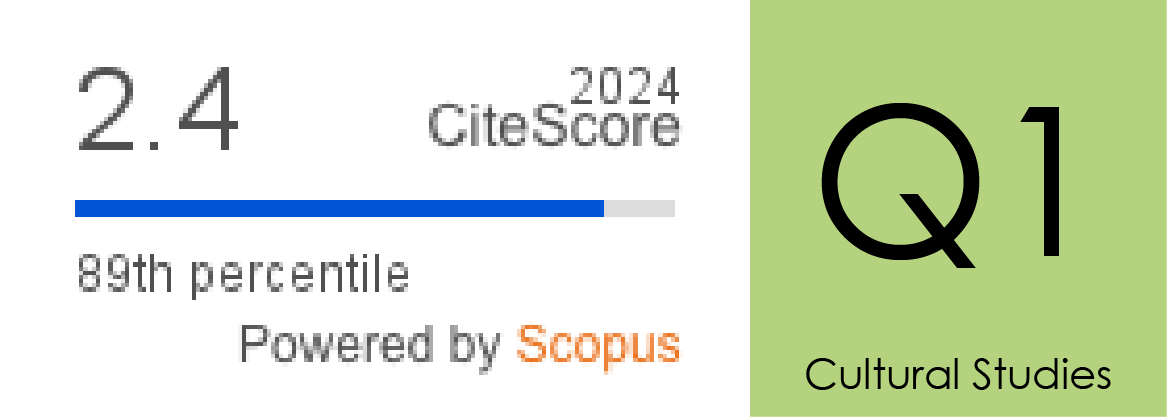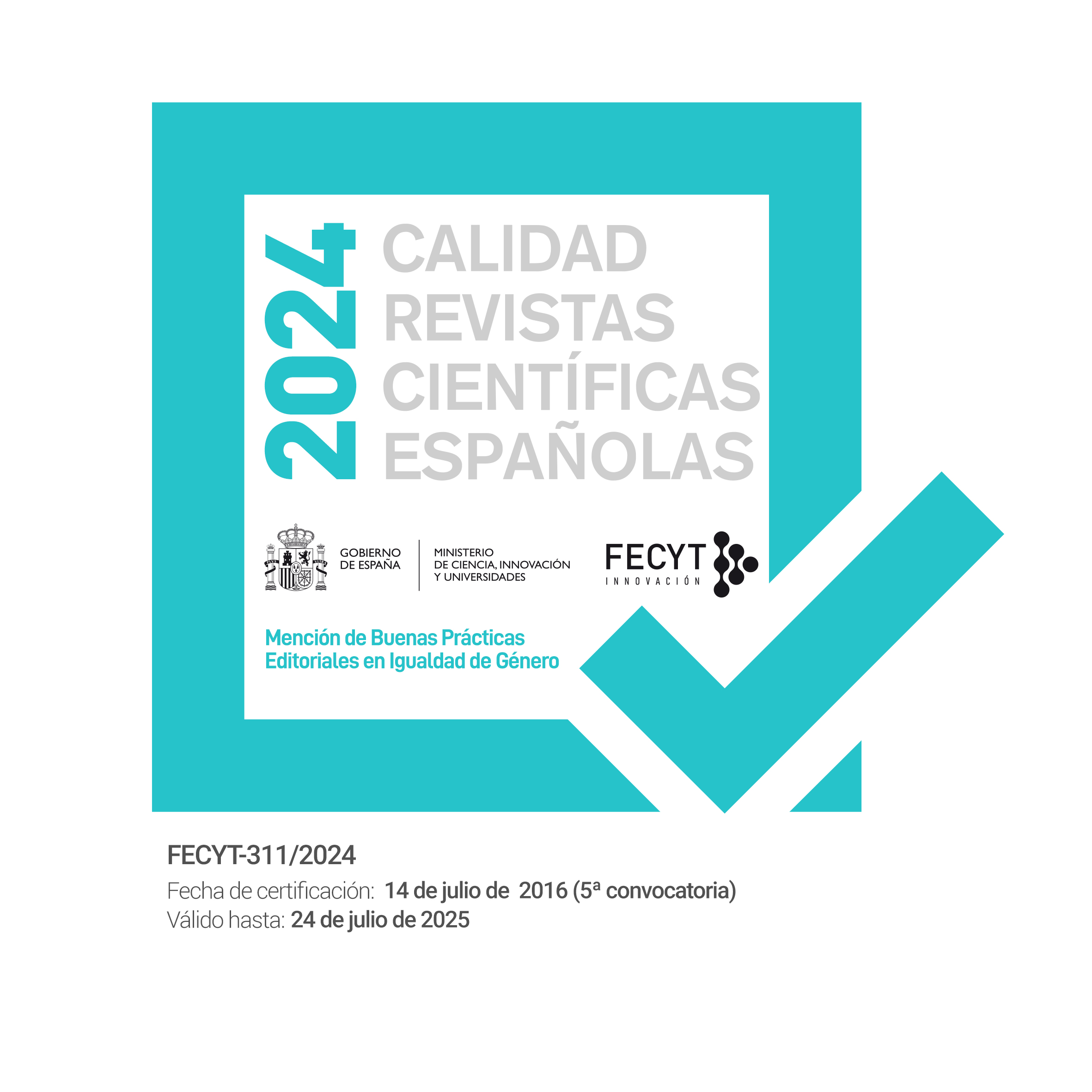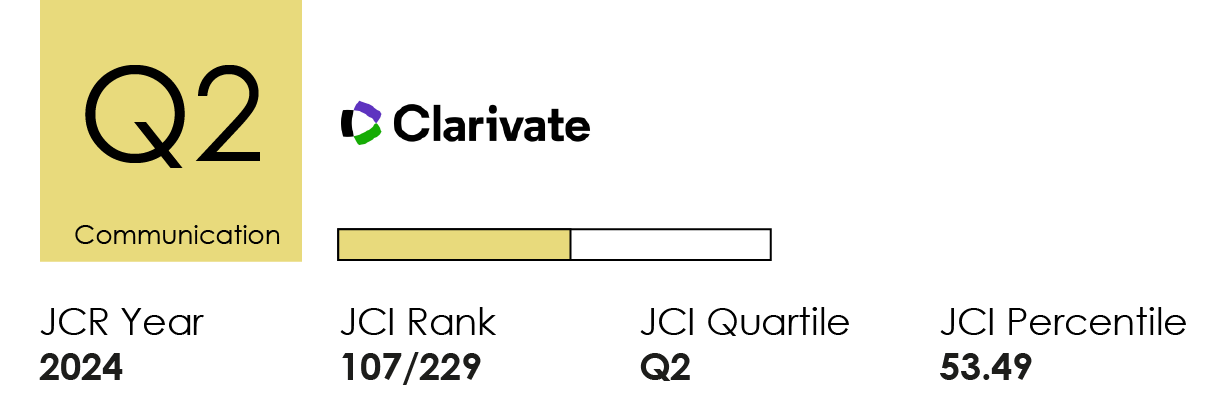Géneros e formatos televisivos da comunicação em saúde na televisão: O talk show Diga Doutor
DOI:
https://doi.org/10.14198/MEDCOM.19870Palabras clave:
Género, formato, talk show, Diga Doutor, comunicação em saúde, estudos televisivosResumen
O artigo foca-se na caracterização do talk show sobre saúde Diga Doutor, na sua qualidade de género e de formato televisivo. A moldura teórica são os estudos televisivos e o método é o qualitativo, que inclui a entrevista semiestruturada e em profundidade à editora de conteúdos e ao médico-apresentador do programa, a análise da retórica a 12 episódios da última temporada do programa e o focus group composto por seis idosos, para assim se explorar respetivamente três componentes da comunicação: o emissor, a mensagem e o recetor. Os resultados indicam, sob a perspetiva do emissor, o compromisso com uma solução heterogénea e rica e a adoção de um estilo similar ao da consulta clínica, que permite, televisivamente, atingir o “maior número de pessoas possível”, sem se ser “demasiado simplista”. A análise à mensagem revela a diversidade temática e a presença de argumentos ligados ao ethos, pathos e logos, da retórica de Aristóteles. Os recetores realçam os contributos cognitivos, afetivos e comportamentais do programa, mostrando a articulação entre a identidade do programa e o gosto do público. O formato do programa manifesta-se nas sub-rotinas, como: o foco no “interesse público” e em “assuntos importantes” sobre saúde, a estrutura composicional, o segmento de comunicação interpessoal entre médico e telespetador, a presença in loco de especialistas e pacientes que partilham os seus testemunhos relacionados com a doença e/ou com a sua superação, os critérios de seleção do médico convidado e do paciente, a presença do “lado humano”.
Citas
Alarcón, E. V. & Galeote, L. C. (2020). COVID-19 media coverage on Spanish public TV. Tripodos, 47(2), 103-125. https://doi.org/gfwh
Ali, F. & Rahman, B. H. (2018). Political bias in talk shows: A case of MQM in local bodies election 2015. Journal of Media Studies, 33(1), 1-23. https://bit.ly/3i3ZqRv
Almeida, C. y Sebastião, S. (2018). A perceção dos profissionais de saúde sobre fontes de informação e sua influência na relação terapêutica. Observatorio (OBS*), 12(4), 26-43. https://doi.org/gfwj
Aristóteles. (século IV a.C./2005). Retórica. Lisboa: Imprensa Nacional-Casa da Moeda.
Aristóteles. (century IV B.C./2004). Rhetoric. n.l.: Courier Corporation.
Bakhtin, M. (1986). Speech genres and other late essays. Austin: University of Texas Press.
Bate, P. (2004). The role of stories and storytelling in organisational change efforts: A field study of an emerging “community of practice” within the UK National Health Service. In B. Hurwitz; T. Greenhalgh & V. Skultans (Eds.), Narrative research in health and illness (pp. 325-348). Oxford, England: Blackwell.
Belim, C. & Filipe, P. (2019). «Mirror, mirror, on the wall, who's the most/less European of them all?». Refugees and leader communication patterns. Problemi dell’informazione, 145-174.
Belim, C. & Vaz de Almeida, C. (2018). Healthy thanks to communication: A model of communication competences to optimize health literacy – Assertiveness, clear language, and positivity. In V. E. Papalois & M. Theodospoulou (Eds.), Optimizing health literacy for improved clinical practices (pp. 124-152). Hershey, PA, USA: IGI Global.
Bignell, J. (2012). An introduction to television studies. London, England; New York, USA: Routledge.
Bignell, J. (2019). Performing the identity of the medium: Adaptation and television historiography. Adaptation, 12(2), 149–164. https://doi.org/gfwk
Borges, J. y Júnior, V. (2008). A construção do sentido e a retórica das empresas na web. Cadernos EBAPE.BR, 6(5), 1-21. https://doi.org/gfwm
Brega, A. G.; Freedman, M. A. G.; LeBlanc, W. G.; Barnard, J.; Mabachi, N. M.; Cifuentes, M.; Albright, K.; Weiss, B. D.; Brach, C. & West, D. R. (2015). Using the health literacy universal precautions toolkit to improve the quality of patient materials. Journal of Health Communication, 20(2), 69-76. https://doi.org/gfwn
Burgoon, J. K.; Birk, T. & Pfau, M. (1990). Nonverbal behaviors, persuasion and credibility. Human Communication Research, 17(1), 140-169. https://doi.org/ffhn2c
Burzyńska, J.; Binkowska-Bury, M. & Januszewicz, P. (2015). Television as a source of information on health and illness: Review of benefits and problems. Progress in Health Sciences, 5(2), 174-184.
Carlson, M. (2015). Introduction: The many boundaries of journalism. In M. Carlson y S. C. Lewis (Eds.), Boundaries of journalism (pp. 1-18). NY, USA: Routledge.
Casey, B.; Casey, N.; Calvert, B.; French, L. & Lewis, J. (2002). Television Studies: The Key Concepts. New York, USA: Routledge.
CENGAGE. (2019). Reality television. https://bit.ly/3i97JeP
Cline, R. (2003). Everyday interpersonal communication and health. In T. Thompson; A. Dorsey; K. Miller y R. Parrott (Eds.), Handbook of health Communication (pp. 285-313). NJ, USA: Lawrence Erlbaum Associates.
Corbett, E. (2004). Classical rhetoric. In J. Rivkin & M. Ryan (Eds.), Literary theory, an anthology (pp. 142-161). Maiden: Blackwell.
Cortès, J. (1999). La estrategia de la seducción: La programación en la neotelevision. Madrid, España: Eunsa.
Crouch, E.; Dickes, L.; Davis, A. & Zarandy, J. (2016). The effects of Dr. Oz on health behaviors and attitudes. American Journal of Health Education, 47(6), 373-378. https://doi.org/gfwq
Din, A. M.; Shahid, A. & Muhammad, A. (2021). Use of constructive approach in talk shows: A case of post corona raised social, economic and religious issues in Pakistan. Journal of Media Studies, 36(1), 1-22. https://bit.ly/2Rbx1Ow
Dutta, M. (2007). Health information processing from television: The role of health orientation. Health Communication, 21(1), 1-9. https://doi.org/dtp7qv
Edgerly, S.; Gotlieb, M. & Vraga, E. (2016). “That show really spoke to me!”: The effects of compatible psychological needs and talk show host style on audience activity. International Journal of Communication, 10, 1950–1970. https://bit.ly/34u5E51
Emerson, R. W. (1860). The conduct of life. Boston, USA: Ticknor and Fields.
ERC. (2016). As novas dinâmicas do consumo audiovisual em Portugal. Lisboa, Portugal: ERC.
European Comission. (2019). Public opinion in the European Union. Belgium: EC.
Floyd, K. (2011). Interpersonal communication: The whole story. New York, USA: McGraw-Hill.
Green, S. (2004). A rhetorical theory of diffusion. Academy of Management Review, 29(4), 653-669. https://doi.org/cjnpd7
Grupo Marktest. (27/03/2020). Covid 19 nos media. https://bit.ly/3yNaokn
Haidt, J. & Seder, P. (2009). Admiration and awe. In D. Sander & K. Scherer (Eds.), Oxford companion to affective science (pp. 4–5). New York, NY, USA: Oxford University Press.
Hartelius, E. & Browning, L. (2008). The application of rhetorical theory in managerial research. Management Communication Quarterly, 22(1), 13-39. https://doi.org/fxdr27
Hermann, R. & Brewer, M. B. (2004). Identities and institutions: Becoming European in the EU. In R. K. Hermann; T. Risse & M. B. Brewer (Eds.), Transnational identities. becoming European in the EU (pp. 1-22). Lanham, MD: Rowman & Littlefield.
Hill, A. (2005). Reality TV: Audiences and popular factual television. London, UK; New York, NY: Routledge.
Hoffman, B.; Shensa, A.; Wessel, C.; Hoffman, R. y Primack, B. (2017). Exposure to fictional medical television and health: A systematic review. Health Education Research, 32(2), 107-123. https://doi.org/f9wb74
Holt, R. & Macpherson, A. (2010). Sensemaking, rhetoric and the socially competent entrepreneur. International Small Business Journal, 28(1), 20-42. https://doi.org/cxmmn3
Howard, T.; Jacobson, K. L. & Kripalani, S. (2013). Doctor talk: Physicians’ use of clear verbal communication. Journal of Health Communication, 18(8), 991–1001. https://doi.org/ghpht9
Hunt, J. & Smith, M. (1987). The persuasive impact of two-sided selling appeals for an unknown brand name. Journal of the Academy of Marketing Science, 15(1), 11-18. https://doi.org/ck5vcw
Ilie, C. (2006). Talk Shows. In K. Brown (Editor-in-Chief), Encyclopedia of Language & Linguistics (vol. 12, pp. 489-494). Oxford, England: Elsevier.
Immordino-Yang, M. H. & Sylvan, L. (2010). Admiration for virtue: Neuroscientific perspectives on a motivating emotion. Contemporary Educational Psychology, 35(2), 110–115.
INE (2002). O envelhecimento em Portugal: Situação demográfica e socio- económica recente das pessoas idosas. Lisboa, Portugal: INE.
Jeong, J. & Lee, S. (2018). The influence of information appraisals and information behaviors on the acceptance of health information: A study of television medical talk shows in South Korea. Health Communication, 33(8), 972-979. https://doi.org/gfwr
Kaina, V. & Karolewski, I. P. (2009). EU governance and European identity. Living Reviews in European Governance, 4(2), 1-41. https://doi.org/gfws
Katz, E.; Blumler, J. & Gurevitch, M. (1973). Uses and gratifications research. Public Opinion Quarterly, 37(4), 509-523. https://doi.org/bw3sm7
Kavka, M. & West, A. (2004). Temporalities of the real: Conceptualizing time in reality TV. In S. Holmes & D. Jermyn (Eds.), Understanding reality television (pp.136-153). Oxon, UK: Routledge.
Keulman, K. & Koos, K. A. (2014). European identity: Its feasibility and desirability. Lanham, Maryland: Lexington Books.
Kickbusch, I. (2001). Health literacy: Addressing the health and education divide. Health Promotion International, 16(3), 289-297. https://doi.org/fmkcg3
Korownyk, C., Kolber, M. R., McCormack, J., Lam, V., Overbo, K., Cotton, C., Finley, C., Turgeon, R.D., Garrison, S., Lindblad, A.J., Banh, H. L., Campbell-Scherer, D., Vandermeer, B., & Michael-Allane, B. (2014). Televised medical talk shows – what they recommend and the evidence to support their recommendations: A prospective observational study. British Medical Journal, 349(7346), 24-25. https://doi.org/gb3sn8
Lewis, J. (2004). The meaning of real life. In S. Murray & L. Ouellette (Eds.), Reality TV: Remaking television culture (pp. 288-302). New York, NY: New York University Press.
Lind, E. A. & O’Barr, W. M. (1979). The social significance of speech in the courtroom. In H. Giles & R. St Clair (Eds.), Language and social psychology (pp. 66-87). Oxford, England: Blackwell.
Luku, E. (2013). A look at the public sphere in talk show programs in Albania. Mediterranean Journal of Social Sciences, 4(10), 574-579. https://doi.org/gf73
Maduro, M.; Rodrigues, M.; Reis, G.; Silva, N. y Tomé, C. (06/03/2015). Contrato de concessão do serviço público de rádio e de televisão. https://bit.ly/3uye99N
Maibach, E. & Holtgrave, D. (1995). Advances in public health communication. Annual Reviews Public Health, 16, 219-236. https://doi.org/bgqhdr
Marketeer. (2016). 10 tendências globais sobre consumidores. Disponible en https://bit.ly/3pnDTok
Mayeaux Jr, E. J.; Murphy, P. W.; Arnold, C.; Davis, T. C.; Jackson, R. H. & Sentell, T. (1996). Improving patient education for patients with low literacy skills. American Family Physician, 53(1), 205-211.
McQuail, D. (2003). Teoria da Comunicação de massas. Lisboa, Portugal: FCG.
MediaMonitor/CAEM. (2018). Evolução dados de audiência 2018: Diga Doutor e Consultório. Lisboa, Portugal: MMW/YUMI.
Mehl, D. (1992). La fenêtre et le miroir: La télévision et ses programmes. Paris, France: Payot.
Mirrlees, T. & Kispal-Kovacs, J. (2012). Television reader: Critical perspective in Canadian and US television studies. Oxford, England: Oxford University Press.
Mittell, J. (2001). A cultural approach to television genre theory. Cinema Journal, 40(3), 3-24. https://bit.ly/3yNJTLy
Mittell, J. (2003). Audiences talking genre: Television talk shows and cultural hierarchies. Journal of Popular Film and Television, 31(1), 36–46. https://doi.org/d853sp
Mittell, J. (2004). Genre and television: From cop shows to cartoons in American culture. New York, USA; London, England: Routledge.
Monge, P. R. & Eisenberg, E. M. (1987). Emergent communication networks. In F. M. Jablin; L. L. Putnam; K. H. Roberts & L. W. Porter (Eds.), Handbook of organizational communication: An interdisciplinary perspective (pp. 304-342). Newbury Park, California, USA: Sage.
Moyer-Gusé, E. (2008). Toward a theory of entertainment persuasion: explaining the persuasive effects of entertainment-education messages. Communication Theory, 18, 407-425. https://doi.org/ffk8vj
Munson, W. (1993). All talk: the talk show in media culture. Philadelphia, USA: Temple University Press.
Murray-Johnson, L. & Witte, K. (2003). Looking toward the future: Health message design strategies. In T. Thompson; A. Dorsey; K. Miller & R. Parrott (Eds.), Handbook of health communication (pp. 473-495). NJ, USA: Lawrence Erlbaum Associates.
Nabi, R. & Oliver, M. (2009). The SAGE handbook of media processes and effects. California, USA: Sage.
Nielsen-Bohlman, L.; Panzer, A. & Kindig, D. (2004). Health literacy: A prescription to end confusion. Washington, DC, USA: The National Academies Press.
Observatório Português dos Sistemas de Saúde-OPSS. (2016). Saúde: Procuram-se novos caminhos – Relatório de Primavera 2016. Portugal: OPSS. https://bit.ly/3fx0U50
Onu, D.; Kessler, T. & Smith, J. R. (2016). Admiration: A Conceptual Review. Emotion Review, 8(3), 218–230. https://doi.org/gfwv
Paek, H.; Choi, M. & Hove, T. (2017). Intention to view health TV programs in South Korea: An application of the comprehensive model of information seeking. Journalism & Mass Communication Quarterly, 94(2), 526-551. https://doi.org/gbj7z3
Park, S. H.; Chang, H. J. & Kwon, Y. D. (2003). Study on the influence of health information from TV - amusement programs on practice of health behavior. Korean Journal of Health Education and Promotion, 20(1), 187-202.
Perse, E. y Lambe, J. (2016). Media effects and society. NY, USA: Routledge.
Petric, B. (2007). Rhetorical functions of citations in high-and low-rated master’s theses. Journal of English for Academic Purposes 6(3), 238-253.
Rogers, C. R. (1959). A theory of therapy, personality and interpersonal relationships as developed in the client-centered framework. In S. Koch (Ed.), Psychology: a study of a science (pp. 184-256). New York, USA: McGraw-Hill.
Schiffrin, D. (1990). The principle of intersubjectivity in communication and conversation. Semiótica, 80(1/2), 121-151.
Sharf, B. (1990). Physician-patient communication as interpersonal rhetoric: A narrative approach. Health Communication, 2(4), 217-231. https://doi.org/cvmk7v
Sharf, B. & Vanderford, M. (2003). Illness narratives and the social construction of health. In T. Thompson; A. Dorsey; K. Miller & R. Parrott (Eds.), Handbook of health communication (pp. 9-34). NJ, USA: Lawrence Erlbaum Associates.
Stableford, S. & Mettger, W. (2007). Plain language: A strategic response to the health literacy challenge. Journal of Public Health Policy, 28(1), 71-93. https://doi.org/ddv8cw
Stiglitz, J. E.; Sen, A. & Fitoussi, J. P. (2009). Report by the Commission on the Measurement of Economic Performance and Social Progress. https://bit.ly/3c6LWRb
Stroobant, J.; Dobbelaer, R. D. & Raeymaeckers, K. (2017). Tracing the sources. Journalism Practice, 12(3), 344-361. https://doi.org/gfww
Tannenbaum, M. B.; Hepler, J.; Zimmerman, R. S.; Saul, L.; Jacobs, S.; Wilson, K. & Albarracín, D. (2015). Appealing to fear: A meta-analysis of fear appeal effectiveness and theories. Psychological Bulletin, 141(6), 1178–1204. https://doi.org/f7wvhw
Teixeira, J. (2004). Comunicação em saúde: Relação técnicos de saúde – utentes. Scielo Portugal, 22(3), 615-620.
Ting, S. (2018). Ethos, logos and pathos in university students’ informal requests. Journal of Language Studies, 18(1), (234-251). https://doi.org/gfwx
Van der Goot, M.; Beentjes, J. W. J. & Van Selm, M. (2011). Meanings of television in older adults’ lives: an analysis of change and continuity in television viewing. Ageing and Society, 32(01), 147–168. https://doi.org/d54wwp
Van Dijk, T. (2006). Ideologia. Barcelona, España: Gedisa.
Wallington, S. (2014). Health disparities research and practice: The role of language and health communication. In H. Hamilton & W. Chou (Eds.), The Routledge handbook of language and health communication (pp. 168-183). Oxon: Routledge.
.
Descargas
Estadísticas
Publicado
Cómo citar
Número
Sección
Licencia
Derechos de autor 2021 Célia Belim, Sofia Lagido

Esta obra está bajo una licencia internacional Creative Commons Atribución 4.0.
Los autores y autoras que publican en esta revista están de acuerdo con los siguientes términos:
1 Derechos de autor. Los autores y autoras conservan sus derechos de autor, aunque ceden a la revista de forma no exclusiva los derechos de explotación (reproducción, distribución, comunicación pública y transformación) y garantizan a esta el derecho de primera publicación de su trabajo, el cual estará simultáneamente sujeto a la licencia indicada en punto 2. Los autores pueden establecer otros acuerdos adicionales para la distribución no exclusiva de la versión de la obra publicada en la revista, siempre que exista un reconocimiento de su publicación inicial en esta revista.
© Los autores.
2 Licencia. Los trabajos se publican en la revista sujetos a la licencia de Reconocimiento 4.0 Internacional de Creative Commons (CC BY 4.0); los términos se pueden consultar en https://creativecommons.org/licenses/by/4.0/
Esta licencia permite a terceros compartir (copiar y redistribuir el material en cualquier medio o formato) y adaptar (remezclar, transformar y crear a partir del material para cualquier finalidad, incluso comercial), siempre que se reconozca la autoría y la primera publicación en esta revista (Revista Mediterránea de Comunicación (RMC) / Mediterranean Journal of Communication (MJC), Universidad de Alicante, DOI de la obra), se proporcione un enlace a la licencia y se indique si se han realizado cambios en la obra.
3 Política de autoarchivo. Se recomienda a los autores que difundan sus trabajos a través de Internet para favorecer una circulación y difusión más rápidas y, con ello, un posible aumento en la citación y alcance entre la comunidad científica y académica, en las siguientes condiciones:
No se permite a los autores depositar en un repositorio institucional o temático, página web propia, etc., las versiones preprint (versión antes de ser evaluada) o postprint (versión evaluada y aceptada para su publicación) de sus trabajos antes de su publicación, pero sí el artículo final publicado (versión del editor).













